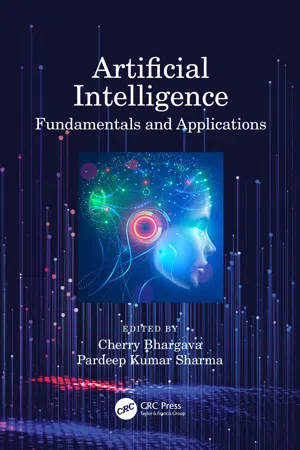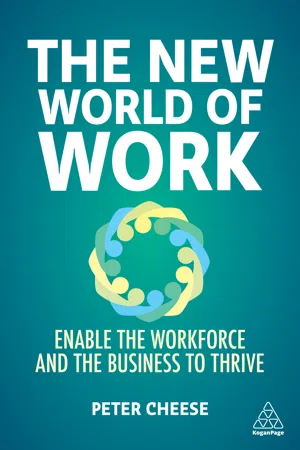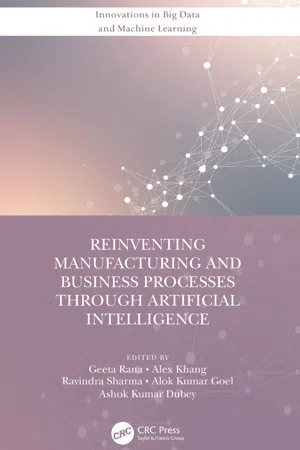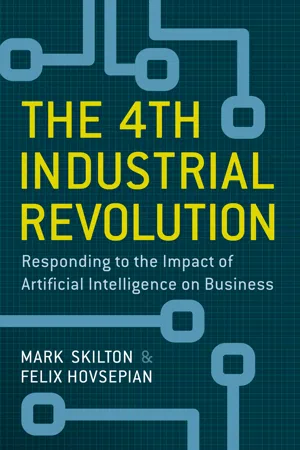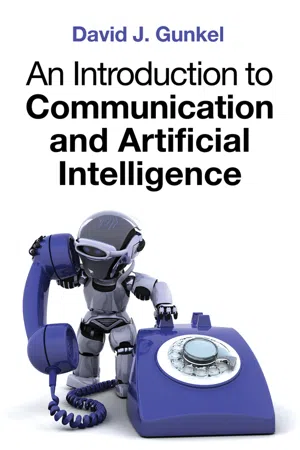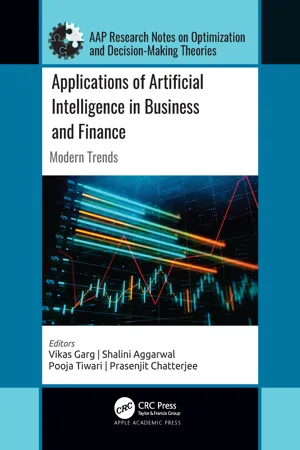Impact of AI and Automation
The impact of AI and automation in computer science encompasses the transformation of various industries through the use of intelligent machines and algorithms to perform tasks traditionally carried out by humans. This includes increased efficiency, productivity, and the potential for job displacement. Additionally, it raises ethical and societal considerations regarding the future of work and the need for retraining and upskilling.
8 Key excerpts on "Impact of AI and Automation"
- eBook - ePub
Artificial Intelligence
Fundamentals and Applications
- Cherry Bhargava, Pradeep Kumar Sharma, Cherry Bhargava, Pradeep Kumar Sharma(Authors)
- 2021(Publication Date)
- CRC Press(Publisher)
...AI is a focused area of science and technology to make machine knowledgeable, which basically means generalized learning, reasoning, analyzing, and understanding of natural languages. These days, the term “AI” envelops the entire concept of a machine that astute in wording of both operational and social results. When the AI is incorporated with robots, there comes a concept of automated bots, and we need to understand that it’s not necessary that robotics always mean to have the physical robots; these can be application bots that work on human instructions and are made to mimic human work and automate the process and from here, the “automation” term is coined, which basically means the replicating human task and integrating these automated bots with AI to make decisions. On the one hand, automation leads to business benefits like cost, time, and a rapid production rate; on the other hand, the automated technologies lead to “technological unemployment.” These technologies have not only suppressed the physical strength of human but also suppressed the human cognitive ability to work and process the huge amount of data and decision-making power. The development of AI and automated technologies can lead a world to better off, but as these technologies are growing, they can lead to a negative impact on society if not handled accordingly. This chapter will discuss the features of automated bots, difference between bots and robots, features and scope of automation, and the technologies that support their implementation, and some of the vulnerabilities. 5.2 History The term “automation” was coined in 1946 by D.S. Harder of Ford Motor industries, and it was used to describe the enhancement in the production line, which basically means replacing human workers with machinery...
- eBook - ePub
The New World of Work
Shaping a Future that Helps People, Organizations and Our Societies to Thrive
- Peter Cheese(Author)
- 2021(Publication Date)
- Kogan Page(Publisher)
...It will impact us all. Technology has therefore been the focus of so much of the debate in recent years about the future of work. But as we have already seen, it is coming together with other significant shifts and changes. Taken together they add up to perhaps a perfect storm, but certainly to a new era. A new era driven by data and artificial intelligence Data is the new fuel of Industry 4.0. And artificial intelligence in its many manifestations is the engine that uses that fuel to drive the new era. Artificial intelligence underpins almost all the new fields of technology. The basic definition of AI is technology that seeks to automate or simulate what we would generally describe as intelligent behaviour. AI in its basic forms has been with us since the 1950s but is now a huge field with many different levels of sophistication and application, enabled by huge advances in data-processing power and capabilities. To better understand AI and its pervasive range of applications, there are some generally accepted classifications 6 which are based on relating AI to human-type intelligence: The most basic AI are ‘reactive machines’, which automatically respond to limited sets of inputs but have no memory. This level of AI has been with us for decades and widely applied. Just think of heating sensors or speed cameras. The next level are ‘limited memory machines’, which can learn from historical data to make ‘decisions’ or alter outputs. This level of AI therefore includes machine learning whereby AI systems repeat tasks and refine their predictive outputs, for example in marketing analytics or chatbots. Within machine learning is so-called deep learning where applications are increasingly able to train themselves to perform tasks without further input – voice- and image-recognition applications would be examples. These first two levels are broadly where we are today. AI at these levels is limited to specific tasks based on predetermined and predefined ranges...
- Geeta Rana, Alex Khang, Ravindra Sharma, Alok Kumar Goel, Ashok Kumar Dubey, Geeta Rana, Alex Khang, Ravindra Sharma, Alok Kumar Goel, Ashok Kumar Dubey(Authors)
- 2021(Publication Date)
- CRC Press(Publisher)
...There is only an AI-driven system or intelligent agents (IA) behind these real world–based applications, which interacts with the environment in a repetitive manner of sense, think and act. It considers data from the environment to make an informed decision based on the input data and previous experience, and at last performs an action affecting the environment. It can work like a machine in industries, home robots or as self-driven cars; it can also work as a software agent like chatbots, recommendation systems, and many more. AI algorithms take the information in the form of images, sound, text, videos, etc., analyze it and deliver AI-powered solutions (Soni et al., 2019). AI not only gives reliability but also provides cost-effectiveness and solves complex problems and helps to come to an accurate decision. Similarly, it controls the missing data will come; that is why it is useful in many fields of business and engineering. Reinforcement learning—which is based on testing success and failure in the real world to increase the reliability of applications—is one of the best tools used in AI, although AI also has its limitations with competency and functionality (Sadek & Chowdhury, 2012). 6.3 FUTURE IMPACT OF ARTIFICIAL INTELLIGENCE ON GLOBAL BUSINESS PRACTICES With the development of AI, its practice has also increased in several ways in international business, which has changed the trade effect at the macroeconomic level; for example, as AI increases productivity and growth, it will lead to an increase in economic growth and gives new opportunities at a global level...
- eBook - ePub
Navigating and Managing an Academic Library
Best Practices from the Arabian Gulf Region
- Judith Mavodza(Author)
- 2022(Publication Date)
- De Gruyter Saur(Publisher)
...2020, 867) Library roles, competencies, and values are being altered because of competing information and data resources, meaning that they must continuously revise what they offer. Additionally, the influence of the Fourth Industrial Revolution is sometimes making librarians view AI as a threat to library relevance. In fact, for continued relevance of LIS professionals, more diversified competencies and skills are important to confront exciting but sometimes volatile, unpredictable, ambiguous, and complex responsibilities. 4.2 Defining AI Using AI has been defined in terms of the programming of computers to do things, which, if done by humans, would be said to require intelligence. According to the Techopedia (2019, n.p.), AI is “an area of computer science that emphasizes the creation of intelligent machines that work and react like humans”. Most AI work involves Machine Learning (ML), and ML is the application of, not the same as, AI. While in ML, computers can handle new situations via analysis, self-training, observation, and experience, AI relies on huge amounts of data and information that enable it to make connections and draw conclusions. This implies that accurate AI-based predictions must depend on accurate data, which Knight (2021) expresses worry about in an article discussing the fact that the foundations of AI are riddled with errors. The ALA (2021, n.p.) mentions that: Artificial intelligence seeks to create “intelligent” machines that work and react more like humans. AI developments rely on deep learning, machine learnings, and natural language processing that help computers accomplish specific tasks by processing large amounts of training data to help the system recognize patterns, input data to drive predictions, and feedback data for improving accuracy over time. An example is in Digital Humanities where large or dense cultural datasets are used to process and interpret the past while attempting to predict the future...
- eBook - ePub
The 4th Industrial Revolution
Responding to the Impact of Artificial Intelligence on Business
- Mark Skilton, Felix Hovsepian(Authors)
- 2017(Publication Date)
- Palgrave Macmillan(Publisher)
...Part IV The Impact of Artificial Intelligence on Business © The Author(s) 2018 Mark Skilton and Felix Hovsepian The 4th Industrial Revolution https://doi.org/10.1007/978-3-319-62479-2_11 Begin Abstract 11. Example Case Studies of Impact of Artificial Intelligence on Jobs and Productivity Mark Skilton 1 and Felix Hovsepian 2 (1) Knowle, Solihull, UK (2) Meriden, UK Mark Skilton (Corresponding author) Email: [email protected] Felix Hovsepian Email: [email protected] End Abstract Introduction “If there is a chance to improve and upscale the quality and efficiency of systems and operations, why wouldn’t everyone take the opportunity?” was raised by a Nikhil Kulkami, a recent graduate. He is very much the next generation that will have much to say in how the workplace and society will change. This is the scope of where we are planning to head, especially with the drive to implement more intelligent solutions for the infrastructures available in today’s society; this drive is being achieved through integrating artificial intelligence (AI), which is the goal of allowing ‘computer systems to exhibit intelligence in some manner’ [ 1 ]. Artificial intelligence has progressed from the development standpoint in computer science to being fully used to extract, analyse and predict vast amounts of data in varying industries. The integration of technologies like AI is helping improve the operation and efficiency of several infrastructures, as well as reducing their financial costs. The next section in this document highlights real examples of industries which have implemented artificial intelligence in their daily processes. We provide a summary table for quick reference of the types of Artificial Intelligence and the pragmatic impact of these in managing planned and unplanned outcomes...
- David J. Gunkel(Author)
- 2020(Publication Date)
- Polity(Publisher)
...Part III Impact and Consequences 8 Social Issues Key Aims/Objectives To introduce and critically investigate the concepts, historical trajectory, and current situation regarding automation and technological unemployment. To identify the challenges to existing educational concepts, structures, and methodologies introduced by workplace automation, and to consider both “updates” and “mods” that can be implemented to respond to these challenges. To “future proof” education and student careers in order to be prepared to meet the demands of the twenty-first century. Introduction As we have seen in our investigations, we are in the midst of something like a robot invasion. Intelligent (or at least, semi-intelligent, or what can also be called “smart”) machines are everywhere and doing virtually everything. We chat with them both on- and offline, we interact with them at work and at play, and we rely on their seemingly inexhaustible and ever improving capabilities to manage many aspects of our increasingly complex data-driven lives. This “invasion” is not something that takes place as we have imagined it in decades of science fiction literature and film. It does not happen by way of a marauding army of evil-minded androids descending from the heavens with ray-guns of immeasurable power. It is an already occurring event with intelligent and autonomous technology of various configurations and capabilities coming to take up positions in our world through a slow but steady incursion. It looks less like Terminator and Battlestar Galactica and more like the Fall of Rome. Each day, what had previously been mere technological objects seem to become a new kind of social actor and communicative subject. Until one day...
- eBook - ePub
- Vikas Garg, Shalini Aggarwal, Pooja Tiwari, Prasenjit Chatterjee, Vikas Garg, Shalini Aggarwal, Pooja Tiwari, Prasenjit Chatterjee(Authors)
- 2021(Publication Date)
- Apple Academic Press(Publisher)
...As a result, it easy to maximize the profit and minimize the cost. Plan for Tomorrow: Man-made intelligence accommodating in estimating the future, to deliver quality merchandise to dazzle the clients to purchase a specific organization item. Their simulated intelligence assists with anticipating the future, as shoppers want to fabricate quality items and supply the products to satisfy the needs. Convince clients to purchase a specific organization item, and AI assists in improving the potential and retailers hand-to-hand to fulfill needs. 1.5 AREA OF ARTIFICIAL INTELLIGENCE (AI) APPROPRIATELY USED AI assumes an exceptionally fundamental job in the present time. Man-made intelligence is nearly utilized by each field like the Education office, Computer science, Medical field, job search, Human Resource planning other fields also in touch of AI. Some of the fields are discussed in subsections. 1.5.1 COMPUTER SCIENCE An AI developer also helps to launched and developed effective methods and techniques to solve the particular problems related to computer science. AI had done too many best ways to solve difficult problems. 1.5.2 EDUCATION The role of AI in the study is commendable because AI fully supports the education sector and to be used too much and effectively to guide the students through modern technology. Some benefits of AI to make easy tasks for the students. AI helps students to query all the typical questions related to the study. Today is technology time easy the student’s life. Through AI, students learn more and more things and easily doing the study very covalently. There are likewise frequent basic and troublesome issues by AI a few times. AI would play a very important role in our education sector if someone understood the AI program. AI helps everyone with problems if they have. Through the AI-enhanced, the knowledge of students and give them better and better options to solve the typical questions...
- eBook - ePub
The Fourth Education Revolution Reconsidered
Will Artificial Intelligence Liberate or Infantilise Humanity
- Anthony Seldon, Oladimeji Abidoye, Timothy Metcalf(Authors)
- 2020(Publication Date)
- University of Buckingham Press(Publisher)
...AI is seductive. It will know more about us than our best friends, our parents, our partners. It probably already does. Under the guise of plausibility, is it opening our eyes, shielding our sight, or blindfolding us? Chapter Ten The Impact of AI on Life and Society Because education impacts all of life, and will become lifelong in the fourth education era, in this final chapter we move beyond the impact of AI on education to how 4.0 might affect life and society at large. There are few more pressing questions for us to grapple with. The Future of Work: Optimists vs Realists This future of employment is so central to the purpose and style of education that we must revisit it. The book Teaching in the Fourth Industrial Revolution (2017), written by six prize-winning teachers, is far from alone in the genre in having virtually nothing to say about AI or the impact of digitalisation on jobs and life. 1 We can hardly say we had no warning of seismic change. It is 130 years since Oscar Wilde visualised machinery ‘doing all the necessary and unpleasant work’, 2 and 90 years since economist John Maynard Keynes discussed the approaching problem of ‘how to occupy the leisure which science and compound interest’ will make possible. 3 Had Keynes encountered AI, he might have predicted change with even more confidence. In the early 1960s, a seminal debate took place at MIT between one group, who saw themselves as ‘realists’, led by John McCarthy and Marvin Minsky, who said AI computers would replace humans in the workplace, and those who said they would complement humans, spearheaded by Norbert Wiener and J. C. R. Licklider. 4 The latter, who we can term ‘optimists’, have had more supporters over the years...
